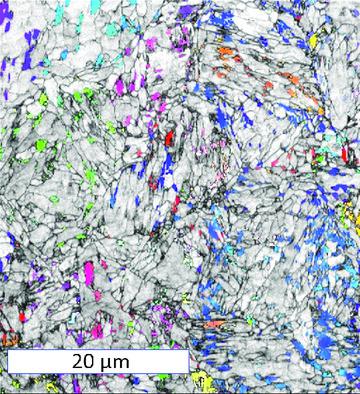当前位置:
X-MOL 学术
›
Steel Res. Int.
›
论文详情
Our official English website, www.x-mol.net, welcomes your feedback! (Note: you will need to create a separate account there.)
Medium Manganese Steel and Mechanism of Austenite Formation during Reversion Annealing
Steel Research International ( IF 2.2 ) Pub Date : 2020-10-03 , DOI: 10.1002/srin.202000381 David Martin 1 , Lena Ryde 2 , Johan Eliasson 2 , Johannes Brask 2 , Bevis Hutchinson 2
Steel Research International ( IF 2.2 ) Pub Date : 2020-10-03 , DOI: 10.1002/srin.202000381 David Martin 1 , Lena Ryde 2 , Johan Eliasson 2 , Johannes Brask 2 , Bevis Hutchinson 2
Affiliation

|
Alloy chemistry and process conditions are studied for a steel having a tempered martensite matrix providing an indicated tensile strength of >900 MPa and containing >20% austenite for enhanced ductility and formability. Conditions equivalent to industrial annealing are simulated in laboratory tests. In the initial quenched state, the steel has a martensitic matrix and contains around 2.5% retained austenite which is maintained throughout the subsequent heating stage and then increases significantly in volume during isothermal reversion annealing above the A1 temperature. There is evidence to support the conclusion that this increase in the austenite content takes place by growth of the pre‐existing fragments of retained austenite in the initial martensitic microstructure, rather than by new independent nucleation events.
中文翻译:

中锰钢及回火退火过程中奥氏体形成的机理
研究了具有回火马氏体基体的钢的合金化学性质和工艺条件,该钢提供了指示的抗拉强度> 900 MPa和包含> 20%的奥氏体,以增强延展性和可成形性。在实验室测试中模拟了相当于工业退火的条件。在初始淬火状态下,钢具有马氏体基体,并包含约2.5%的残余奥氏体,该奥氏体在随后的整个加热阶段均保持不变,然后在等温回复退火中在A 1以上的温度下体积显着增加。温度。有证据支持这样的结论:奥氏体含量的增加是通过在初始马氏体显微组织中残余奥氏体的预先存在的碎片的生长而不是通过新的独立成核事件而发生的。
更新日期:2020-10-03
中文翻译:

中锰钢及回火退火过程中奥氏体形成的机理
研究了具有回火马氏体基体的钢的合金化学性质和工艺条件,该钢提供了指示的抗拉强度> 900 MPa和包含> 20%的奥氏体,以增强延展性和可成形性。在实验室测试中模拟了相当于工业退火的条件。在初始淬火状态下,钢具有马氏体基体,并包含约2.5%的残余奥氏体,该奥氏体在随后的整个加热阶段均保持不变,然后在等温回复退火中在A 1以上的温度下体积显着增加。温度。有证据支持这样的结论:奥氏体含量的增加是通过在初始马氏体显微组织中残余奥氏体的预先存在的碎片的生长而不是通过新的独立成核事件而发生的。


























 京公网安备 11010802027423号
京公网安备 11010802027423号